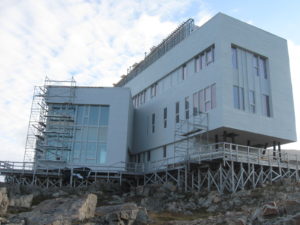
Now there’s a practical alternative to Design-Build called Construction Management. The NL government hasn’t used it because it thinks that such a project delivery method is contrary to Public Tendering philosophy. Of course if they cared a whit about “best value” they would research Construction Management to discover that consultant, construction manager and all sub-trades are competitive proposals / bids. But I’m getting ahead of myself.
In this delivery method, the architect’s team devises the concept based on the Owner’s program. Then, when the detailed design begins to evolve, a Construction Manager is brought in. The CM comes on board and offers up-front advice on constructability and cost. The best CMs will, in fact, take over the cost estimating task and are free to begin construction whenever the budget has been confirmed. The design continues, then construction documents are progressed to completion.
Design-Bid-Build (stipulated price, lump-sum) sets up a mutually aggressive situation between Owner (& consultant) and the General Contractor, as each party has differing agendas. In addition, the General Contractor has no incentive whatsoever to reduce cost. On the contrary, he/she has every incentive to find issues in the design that will lead to extra costs.
By contrast, Construction Management is a cooperative delivery methodology. The CM will review and contribute to the design process, and based on his/her experience, has the opportunity to advise on cost effective construction alternatives. No such opportunity exists under stipulated price, lump-sum tendering.
The CM is also afforded the opportunity to schedule sub-contracts according to the construction season. A General Contractor rarely employs such logic unless there is a profit incentive.
Finally, the Construction Manager can call competitive sub-trade bids sequentially, thus saving time by permitting a start on construction before all the documentation (i.e. design) is complete. This is sometimes referred to as “fast-tracking” although under the CM approach, it is a somewhat redundant term. Sequential bids also help the CM manage an unexpected cost overrun of any given sub-trade scope. That package or a subsequent package may require some design tweaking to make it leaner.
The greatest problem, locally at least, is that many General Contractors also believe they are, by default I guess, Construction Managers. But most contractors these days are simply brokers. Aside from a good site supervisor or two (which they struggle to hold on to) they typically employ engineers who have little in the way of management skills or practical construction knowledge. Of course there are exceptions. Good CMs do exist here, but unfortunately most cannot operate exclusively so, because CM work in Newfoundland and Labrador is rather limited.
The hallmark of a good Construction Manager is the ability to prepare an accurate cost estimate. Many self-proclaimed CMs are unskilled at quantity surveying, and rely on sub-trade bids exclusively. This leads to completely unacceptable padding of the construction budget. The Owner will pay dearly for this, or, once the project is complete, the CM will attribute being under budget to his/her construction management skills. (Right!)
Many private sector companies and non-profit groups employ Construction Management very successfully. Large chain supermarkets will use a CM repeatedly for many years until there is a major screw up. Then the CM will invariably be dumped. It tends to be rather cyclical.
Fortis and the Salvation Army are owners that have had good success with Construction Management. It is an enlightened approach – part of a corporate culture that is informed with experience based on an almost continuous need for construction services.

Construction Management with a contractor that focuses on this delivery methodology as a niche, can be rewarding. Everyone has the same objective – that of providing the highest quality built environment for the most cost-effective price. It is a system grounded in teamwork and the value of relationships.
Construction Management, in my personal opinion, offers best value. It is unlikely however, that the civil servants promulgating the new Public Procurement Act will ever come to this conclusion. The newly minted Public Procurement Regulations under 3(1)(c) Procurement Planning state “that a public body shall determine the appropriate procurement tool to ensure best value is received”.
You would think therefore that there would be a great deal of forethought and commensurate text to supplement this very noble statement … but there isn’t. The only other reference in the entirety of the regulations is buried under 17(3): “Where a public body determines that a bid … would not result in best value as the price is not fair and reasonable, the public body may negotiate the price of the contract with the supplier or may cancel the open call for bids”.
So consider that for a moment.
If you came to the conclusion that this clause allows any provincial or municipal body the ability to do whatever the hell they want – top of the class for you. Many had hoped that public sector construction would, under the new Act, actually benefit from best value. The new regulations have killed that dream.
In addition, since architectural services are now subject to and governed by the new Act, prayers for best value or quality-based selection have gone up in smoke. In years gone by, consultant awards were made by a trio of cabinet ministers who awarded projects to whoever was supporting the party through direct contributions, business dinners or golf games. At least you could hone your business model to address the reality of the political pig trough. It was your choice to satisfy the political bagman at your door with a cheque or exclusively chase private sector work.
Now it’s hard to know what to do.
Best value.
It’s like beauty I guess – it’s in the eye of the beholder.
